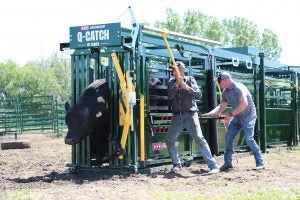For years, manual and self-catch cattle head gates have been a strong discussion point between ranchers. Head gates are useful in many situations — whether it be for milking, medical treatments, branding, tagging, or other various procedures, cattle head gates are essential for keeping your cattle secure and ensuring everyone, including the cattle, are kept safe.
When it comes to choosing the right head gate for your operation, having so many choices can be intimidating, especially when it comes to choosing something that is within your budget but also dependable, effective, and works with animal science. Both self-catch and manual head gates have their own benefits as well as drawbacks.
What is a self-catch head gate?
This type of cattle head gate is designed to automatically catch cattle by using the animals’ force to trigger a set of locking mechanisms. Self-catch head gates are meant to be more hands off. This, however, isn’t always the case.
Self-catch head gates need to be readjusted for every animal that runs through your chute, if they are different sizes. If the head gate is set too wide from the animal before, you can risk hip-lock, and if it’s not open enough, your cattle won’t get through, taking more time to back up the cow, readjust the head gate, and get back to work.
Considerations:
Cattle are very smart and are known to remember negative experiences for a long time, such as experiencing the impact of a self-catch head gate. After one negative experience, cattle may become chute shy as they start to anticipate the impact of the head gate closing around their neck and become reluctant to enter the chute.
This can cause your cattle to become difficult to work with, which will raise stress levels for you and your cattle alike, which, as all ranchers know, isn’t good. When considering what head gate might be right for your operation, you need to consider how effective each one will be for the tasks you’ll be doing and how often you’ll be using it.
Benefits:
A benefit to self-catch cattle head gates is they can be more affordable up front. This can be good if you’re on a budget, but you also need to keep in mind that you tend to get what you pay for. Self-catch head gates require more levers and locks, which can lead to more going wrong and replacing parts more often.
Self-catch head gates may also work better for someone with a smaller herd of similar size, compared to a large ranch or cow-calf operation with cattle of various sizes. Though these head gates are often advertised as a one-person operation, this can be complicated by the constant need for adjustments and handler intervention and may require more than one person to work cattle.
What is a manual head gate?
These head gates give the handler complete control to catch the cattle with swift movements. These types of head gates also often only require one or two levers to operate, making the process not only easier, but a true one-person operation.
When compared to self-catch, manual head gates are usually simpler to operate and don’t need to be adjusted for different sizes of cattle. Rather than requiring the operator to adjust locks, some manual cattle head gates use an automatic adjusting or infinite locking system that allows you to securely catch the animal you currently have in the chute.
Considerations:
Although more user-friendly, manual head gates can be a bit more costly up-front and getting your timing right can take some practice. If the initial cost is more than you anticipate, remember that investing in a cattle chute with a manual head gate can lead to a better return over time as they usually require less maintenance.

Manual head gates can also be a bit of a learning curve. Just because you miss a few catches in the beginning, doesn’t mean your purchase wasn’t worth it. Once you get the process down, you’ll be working your cattle faster than ever, and saving yourself time and effort.
Benefits:
Manual cattle head gates also tend to operate quieter, which greatly reduces stress for cattle, and for you. This is beneficial for working cattle through the chute efficiently, as well as for weight gain, meat quality, and immunity.
With a manual head gate, you also don’t tend to deal with chute shyness once your cattle have been acclimated to your equipment, as there’s no force required for cattle to enter and be secured in the head gate. You simply open the head gate with a handle, and close it around the animal, usually right behind their ears.
When cattle don’t have to physically connect with a head gate to close it, the chances of bruising are also drastically reduced. This is very important, as the quality and grade of bruised meat is greatly reduced which can cost the beef industry millions each year.
Which is your best option?
There are a lot of things to consider when purchasing new cattle equipment, which is why you want to ensure you choose to do business with a company that stands behind their equipment with warranty programs. A company that also stands behind not only their products, but also the customer, is worth considering.

Though there are many differences between manual and self-catch cattle head gates, one thing remains true: a head gate is one of the most important investments you can make. By doing research and selecting the option that is best for you and your operation, you are guaranteed to set yourself up for continued success.
This article was published on behalf of Arrowquip.


